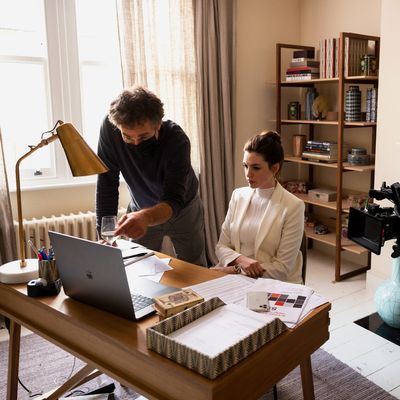
For Doug Liman, the process of shooting a film called Locked Down during the coronavirus-induced lockdown — a movie that will, in all likelihood, be watched by people still stuck in lockdown — began with what he terms “an insane idea.” Over a Zoom meeting in July, the filmmaker behind hits like Edge of Tomorrow and The Bourne Identity hatched a plan with screenwriter-producer Steven Knight (Peaky Blinders, Eastern Promises) to write a screenplay, land financing, and rush into physical production by no later than September 2020.
Despite a near-industrywide halt in filming (the megabudget event titles Mission: Impossible 7 and Jurassic World: Dominion being rare exceptions at the time), as well as the almost “completely uninsurable” nature of their project, Liman and Knight felt assured they could pull off their stunt. The end result? Locked Down was shot with blistering speed last year and will arrive on HBO Max on January 14. In the seriocomic feature, Anne Hathaway and Chiwetel Ejiofor play a London-based couple on the verge of breakup; suffering through forced quarantine cohabitation, they hatch a plan to pull an audacious jewelry heist at Harrods, the world’s most glamorous (and heavily fortified) department store.
“The script and our experience of making the film are almost the same story,” Liman tells Vulture via Zoom conference link. “Because Steve and I are locked down and we’re like, ‘Let’s escape by attempting this insane thing.’ When there’s nothing going into production, every actor is available. We’d be the first independent film. It’s totally uncharted territory.”
“And the story we’re going to tell is this couple who attempt this audacious thing of robbing Harrods,” he continues. “I’m not sure which one was riskier: the stealing of the diamond or the attempting to make a film under these circumstances.”
Liman, of course, is no stranger to exploding the boundaries of conventional filmmaking to suit his whims. Over the course of a storied quarter-century career that encompasses his 1996 indie breakthrough Swingers, the Palme d’Or–nominated biopic Fair Game, and the action-comedy Mr. & Mrs. Smith (the crucible in which the the tabloid entity known as Brangelina was forged in 2005), he has repeatedly infuriated collaborators, ignored studio “notes,” and gone way overtime and tens of millions of dollars over budget in pursuit of his own subjective variety of cinematic excellence — a process detractors and admirers alike now know as “Limania.”
Directing Tom Cruise in the 2014 sci-fi action-thriller Edge of Tomorrow, a planned two-week shoot involving an alien invasion on France’s Normandy Beach stretched into three months of grueling, simulated combat courtesy of the director’s self-described “workshop-y” style. During filming on Bourne in 2001, the director kept his production crew overtime to light a forest outside Prague so that Liman could play paintball. Then, when production delays, general on-set chaos, and screaming arguments with producers on that film culminated in a $10 million budget overrun, Liman reportedly considered selling his director’s credit on eBay (with then–Universal chair Stacey Snider threatening that he was “never going to work again”). Perhaps most notoriously, when 20th Century Fox attempted to place stricter financial boundaries on the filmmaker after Mr. & Mrs. Smith went $26 million over budget, Liman famously dipped into his own savings account to build a set in his mother’s garage in upstate New York — then unceremoniously destroyed it with a hand grenade.
For a filmmaker who has shown little compunction about flying by the seat of his pants (in addition to repeatedly flying in the face of filmmaking convention by actually flying … more on that in a minute), Liman established a number of hard-and-fast rules governing production on Locked Down. Before a single word of the script had been written, he and Knight endeavored to make something that could be shot “safely,” in which the leads could exist in a quarantine bubble and almost everyone else could be filmed from a distance. Actors were cast on the basis of certain real-life parallels: Ben Stiller, for one, landed the role of Hathaway’s smarmy boss in part because he, like the character, had a teenage son living with him under shelter-in-place rules. Anticipating that the pandemic would worsen over the course of the shoot, they would film quickly. And the whole thing would be done on the ultracheap — although Liman declined to reveal how much Locked Down cost, he waved away a report the film had been shot for $10 million, insisting its actual budget “started with a three.”
“The idea was I would do it on spec, Steve Knight would do it on spec,” says Liman, using industry lingo for “on speculation” — that is, unsolicited by a studio, without commission from any financial backer and therefore much more risky for the creative team. “I was like, ‘As long as we keep our production budget … we can go in without COVID insurance.’ The approach was: We’re going to do this as cheaply as we possibly can because we don’t know if it’s going to be possible to finish this movie.”
The entire cast, which also includes Ben Kingsley, Mindy Kaling, Stephen Merchant, and Lucy Boynton, signed on without reading a finished script. The understanding was there would be no reshoots, and the dialogue they enacted would effectively be the “first draft” of Knight’s script.
For Ejiofor and Hathaway, the breakneck pace of completing principal photography in London in just 18 days required some unusual actorly shortcuts as well as a newfound tolerance for Limania. “One particular day, it started raining when it wasn’t supposed to and I needed to change the order of scenes,” the director recalls. “I turned to Annie and Chiwetel and I was like, ‘I have to shoot tomorrow’s work today.’ And Chiwetel’s like, ‘I haven’t even looked at it yet.’ And Annie’s like, ‘I started memorizing it but by no means do I have it memorized.’”
The week before, Liman recalls, he and his cast had been laughing at a picture from The Godfather, in which Marlon Brando has his lines taped inside another actor’s jacket. Just a handful of days later, it was an acceptable practice for their set. “For that scene, we actually had to tape lines wherever [Hathaway’s and Ejiofor’s] eyelines were and just go. And it’s my favorite scene in the movie, by the way,” Liman says. (Hathaway, for her part, called shooting under curve-flattening circumstances both “very normal” and “completely wild.”)
Locked Down’s third act was entirely contingent on the cooperation of Harrods: the Knightsbridge luxury menagerie which had never ceased operation in its 172-year history, and moreover, never allowed a film to shoot within its walls. Harnessing the same kind of “the world’s been turned upside down, normal rules no longer apply, and why not?” outlook as their characters, Liman and his producers approached the department store in July anticipating tricky negotiations. “We said, ‘We don’t have a script. We don’t have an idea for a movie. In fact, if you don’t say yes, we’re not going to write the script because we don’t have a Plan B. It can only be Harrods,’” the director recalls. “Under normal circumstances, Harrods would never have said yes. But again, these are not normal circumstances.”
The store not only relinquished its food halls and retail showrooms to the production, Harrods enlisted its staff to stand in as extras and even allowed the filmmakers access to its innermost sanctum. “We decided we wanted to shoot in the Harrods vault — that’s where the diamond [the characters want to steal] would come from,” Liman says. “And Harrods was like, ‘No, that’s our vault.’ And we’re like, ‘Okay, would you let us just see your vault? Just so we can try to re-create it somehow?’ It’s in this secret place in the building. They took our production designer and he took some pictures. From there, they were like, ‘Okay, we’ll let everybody in. You can shoot in the vault. You just can’t show where it is in the building.’ I found myself in the vault with my producer Alison Winter. There’s an air lock to get in. The person who brought us there went out. I look at Alison and I’m like, ‘We are alone in the Harrods vault. We have literally become one with our characters.’”
Where Locked Down can be understood as a kind of exercise in pushing the limits of cinematic restraint — in finding unexpected freedoms in enforced enclosure, let’s say — Liman’s next movie aims to blaze into even less-charted territory. In May, Deadline announced he would “boldly go where no film director has gone before,” shooting an independently mounted action-adventure feature starring Tom Cruise in space. Elon Musk’s Space X and NASA are somehow reportedly involved. To date, little else has been revealed about the project.
Liman demurs when I ask about that film’s plot points, timeline, and gravity-defying logistics, saying he’s “not ready to talk about that yet.” But as a licensed pilot who flies his own light aircraft whenever his busy schedule permits, the director revealed an unexpected way making Locked Down helped him prepare — not only to escape Earth’s orbit with Cruise but to keep pace with his own Limania.
“I flew myself across the Atlantic to make this film,” the filmmaker says of Locked Down. “It was terrifying. Landing in Greenland is not for the faint of heart! Most people think of astronaut training as being very physical, but it’s more like pilot training. I just thought I should push myself outside of my comfort zone. Because it’s going to be terrifying to go into outer space. I think because of the space film, I’m in a mindset where I’m more open to taking big, big swings.”





